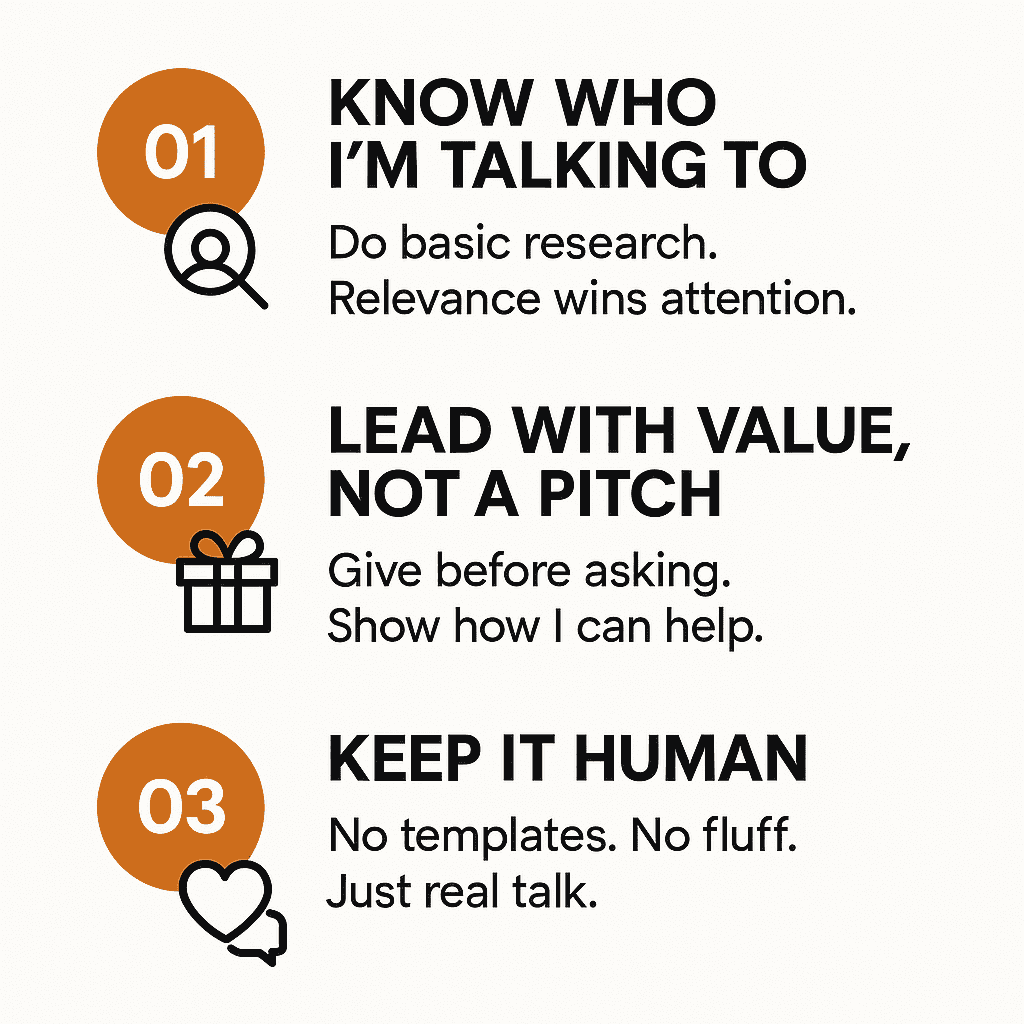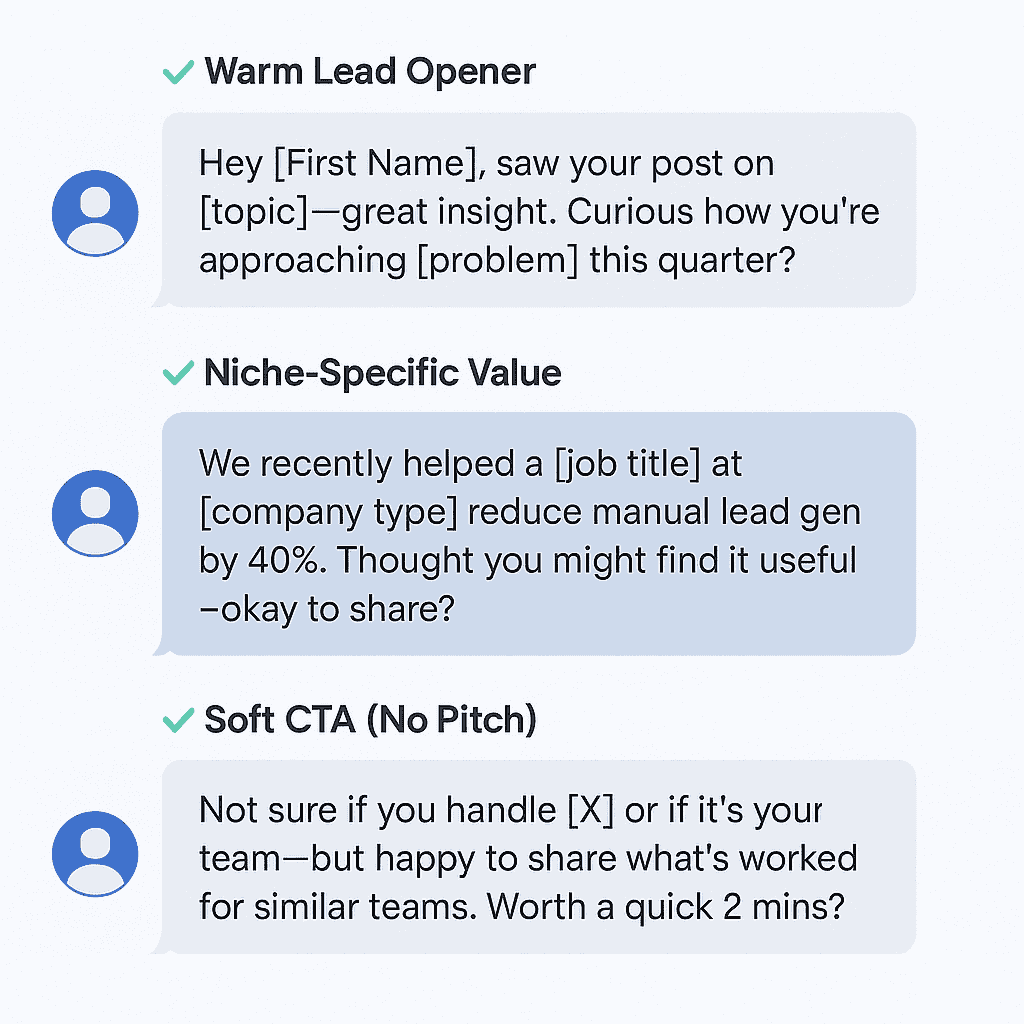Why LinkedIn Works (If You Use It Right)
Executives are active on LinkedIn. They’re scrolling, posting, lurking—and most importantly, making decisions.
But here’s the catch: they’re busy as hell.
Your message has to cut through the noise fast. That means no fluff. No pitching right away. No “Hope you’re doing well” (at least not as the opening line).
You need to earn their attention in seconds. And if you do it right, you get way more than a reply—you build trust and even long-term opportunities.
The 3 Principles I Follow Before Messaging Anyone

Before I even start writing a message, I check myself against these 3 principles. If I ignore these, my reply rate tanks.
1. Relevance > Personalization
Sure, it’s nice to mention the school they went to. But relevance is king. If your message doesn’t relate to their goals, pain points, or business… it’s a waste.
I always ask: “Why should this person care about this message today?”
2. Less is More
My best-performing cold messages are under 300 characters. Busy execs don’t have time to read your life story. Short, sharp, and skimmable wins.
3. Be Human, Not a Salesbot
People don’t connect with scripts—they connect with people. I write like I’m texting a smart, time-starved friend.
Step 1: Research Like a Pro.
Before messaging, I always spend 2–5 minutes researching. Here’s what I look at:
- Their recent posts (Did they share an opinion I can build on?)
- Their company’s focus (What’s trending in their world right now?)
- Their headline/title (What does their role involve?)
- Mutual connections (Can I reference someone without being weird?)
My goal? Find a relevant angle I can naturally use in my message. Not to flatter, but to connect.
I don’t go overboard. If you bring up their dog’s birthday from 2018, you’re just being creepy.
Step 2: Connect the Right Way
Never—never—message someone before sending a connection request. And when you do send the request, keep it light and low-pressure.
Here’s what I usually write in my connection request:
“Hey [Name], came across your post on [topic]—loved your perspective. Would love to connect!”
Once someone accepts, don’t message them immediately like a LinkedIn sniper. It screams automation.
Step 4: Write an Opening Line
The first line is everything.
If it feels like spam, they delete it.
If it feels like work, they ignore it.
If it sparks curiosity, they reply.
Here are a few openers I’ve used that worked well:
- “Quick question about your recent post—mind if I share a thought?”
- “Saw you’re hiring for [X]—had an idea I think could help. Mind if I share it?”
- “You probably get 100 DMs a day, so I’ll keep it super short”
Step 5: Deliver the Value in One Line
This is the heart of the message—and it better be good. I call this my “One-Line Win.”
I always ask: Can this line stand alone and still be worth reading?
Examples:
“I’ve helped similar SaaS teams cut CAC by 25% using outbound flows—thought it might be relevant given your recent funding.”
“You’ve scaled [Company] super fast—curious if you’re exploring ways to automate lead gen without adding headcount?”
“Based on your focus on [X], I mapped out 3 ideas that might unlock extra growth this quarter. Can I share them?”
The goal isn’t to pitch, it’s to tease. I don’t try to sell—I try to start a conversation.
Step 6: Add a Non-Awkward CTA
My rule: No desperate CTAs. No “15-minute calls.”
Busy execs don’t have time for vague “chat requests.” So I give them an easy, low-pressure out.
Some CTAs that work:
- “Happy to send over a few bullet points—if you’re open?”
- “Would it be okay if I shared more details?”
- “If it’s not a fit, totally cool—just figured I’d check.”
Notice the tone? Soft, respectful, and permission-based. That builds trust.
When I get a response, I match their tone and pace. If they reply with “Sure, send it over,” I keep it tight and tailored.
This is where I go from curiosity to credibility.
I might say:
“[Idea 1]
[Idea 2]
Notice again—no long paragraphs. No pitch deck. Just clear, punchy ideas that feel custom-built.
Real Messages That Got Me Replies

To give you something actionable, here are real examples I’ve used:
Cold Message Example #1 – Targeting a SaaS Founder
“Hey [First Name],
Saw [Company] just rolled out a new onboarding feature—congrats! I work with B2B SaaS teams to improve demo conversion using onboarding data (ex: helped [X company] increase by 31%).
Would it be cool if I sent a few ideas your way?”
Why it works: Specific, relevant, tied to a recent update, and no hard pitch.
Cold Message Example #2 – Targeting a CMO
“Hi [First Name]
Saw your post on content fatigue—completely agree. I built a short list of viral content frameworks that work even in saturated niches.
Happy to send if you’re curious?”
Why it works: Referencing their post, offering value, not forcing anything.
Cold Message Example #3 – General Executive Outreach
“Hey [First Name]
I know you probably get a ton of DMs—so I’ll be quick.
I help agencies like [Company] land high-ticket clients without paid ads. Thought it might be relevant if you’re scaling outbound this quarter.
Want me to send a quick breakdown?”
Let me spare you the pain. Here are mistakes that killed my response rate in the past:
- Writing an essay (nobody reads long DMs)
- Sounding robotic or scripted
- Jumping straight into a call ask
- Name-dropping irrelevant companies
- Over-personalizing with no relevance
- Using fake flattery
Instead, keep it real. Keep it sharp. Keep it relevant.
Tools I Use to Make This Easier
I keep my process lean but effective. Here are a few tools that help:
- LinkedIn Sales Navigator – for filtering the right leads.
- Clay, PhantomBuster, or Waalaxy – if I want to scale outreach responsibly.
- Notion or Google Sheets – for tracking conversations and responses.
- ChatGPT – for refining my message ideas and frameworks.
- Loom (sometimes) – for personalized video follow-ups.
But honestly, the tool is less important than the tone and timing. Nail that, and you’re golden.
Final Words
When I shifted my mindset from “How do I sell?” to “How can I serve?”, everything changed. My response rates went up. My calendar filled up. And most importantly—I built real, trust-based relationships.
This process works. It takes patience, tweaks, and a human-first approach.
Conclusion
I’ve thrown a lot at you in this guide—frameworks, scripts, mindset shifts, and cautionary tales—so I want to close by stitching it all together into a single, living philosophy you can carry into every LinkedIn DM you’ll ever write.
Re-centering on the Human
If the answer’s no, I rewrite until it feels like a genuine extension of help rather than a transaction.
The Flywheel Effect
As you put this guide into practice, you’ll notice something fascinating: each successful exchange fuels the next. One executive says yes to reading your bullet-point ideas, you turn that into a case study, and suddenly your next batch of messages contains a real-world proof point that lifts reply rates again.
I call this the flywheel effect—momentum compounds. At first, the wheel feels heavy: hours of research for a single tailored note. But once replies start trickling in, you collect micro-stories, testimonials, and data points that shorten future research cycles and make your one-line value proposition punchier. Eventually, your cold messages aren’t “cold” at all; they’re lightly chilled introductions backed by quiet credibility.
Evolving Beyond Templates
I keep a swipe file of openers and CTAs, sure, yet every time I paste one in, I force myself to edit at least 30 percent of the words. That small rewrite injects situation-specific nuance and protects against autopilot syndrome.
Over time, your voice becomes the template: a distinct cadence, an economy of words, a knack for surfacing one killer insight the recipient hasn’t considered. That is what busy leaders reply to.
Metrics That Matter
Let’s talk numbers—but keep them in perspective. My benchmarks evolved as I matured:
1. Connection acceptance rate: Anything north of 40 percent tells me my initial blurb is on point. Below that, I’m probably name-dropping vaguely or failing to show relevance.
2. Initial reply rate: Twenty-plus percent is my sweet spot. If it dips, I shorten the first message until it’s scannable on a mobile lock screen.
3. Positive response rate: Replies that move the conversation forward (versus polite declines) should hover around 50 percent of all replies. If not, my “One-Line Win” isn’t compelling enough.
4. Booked-call conversion: This varies by the offer, but I aim for 30 percent of positive responses to become calendar events within two weeks.
Notice what’s not here: number of messages sent per day. Volume has its place, yet I’d rather send 15 tailored DMs that book three high-value calls than blast 150 generic ones for the same outcome but a bruised reputation.
Dealing With Silence
Even with an airtight process, you’ll still face radio silence. My philosophy on ghosting is simple: Silence isn’t rejection; it’s feedback. Maybe the timing was off. Maybe the hook didn’t click. Maybe their kid was sick and they never saw the notification And if they truly aren’t interested? Great. I’ve protected my bandwidth and left the relationship on courteous terms for future cycles.
Nurture Over Napalm
Your LinkedIn activity beyond the inbox is silent nurturing. Weekly, I share thinking that aligns with the challenges my ideal executives face. It might be a two-paragraph teardown of a viral marketing campaign or a LinkedIn carousel summarizing three outreach mistakes I learned the hard way. When a prospect who ignored my message six months ago finally needs what I do, guess whose face appears in their feed, adding value on the regular? That slow-burn familiarity often converts colder leads faster than any DM wizardry. Messaging and content aren’t separate universes—they’re tributaries feeding the same river of trust.
Scaling Without Selling Your Soul
Once your reply rates climb, the urge to automate skyrockets. Remember, executives talk; if one CFO shares a screenshot of your cookie-cutter pitch in a Slack community, you could burn an entire vertical. Scale responsibly.
Continuous Improvement Loops
Every Friday, I conduct a 30-minute retrospective:
1. Wins: What message landed a meeting—and why?
2. Misses: Which opener flopped? Was it timing, wording, or targeting?
3. Hypothesis for next week: One variable to test—maybe an even shorter CTA or a Loom video follow-up.
I track changes in a spreadsheet, color-code results, and iterate. One week I replaced “Quick question” with “Left-field idea,” saw a 12 percent bump in replies, and adopted it. Next week it plateaued, I tried something else. Outreach is a living laboratory; treat it like one.
Protecting Your Mindset
Cold messaging can bruise the ego. A day of no replies feels like shouting into the void. My antidote is process pride: I judge success by actions I control—consistent research, authentic tone, timely follow-ups—not by external validations alone. If I hit my controllable commitments, the scoreboard eventually tilts in my favor.
I also celebrate small signals: a like on a comment, a prospect watching my 60-second Loom till the end, even a “Not now, but circle back later.” Those micro-yeses compound into macro wins.
Ethical Anchors
Finally, weave ethics into every line. I never fabricate social proof, inflate results, or claim partnerships that don’t exist. When I occasionally turn away a prospect I’m not best suited for, they often refer someone else precisely because I was honest. Integrity creates unexpected dividends.
My Commitment to You
By putting this guide into practice, you’re not just adopting tactics—you’re joining a quieter revolution against spammy, transactional outreach that gives sales a bad name.
We’re forging a different breed of cold outreach—one where empathy meets efficiency, where brevity coexists with depth, and where the ROI isn’t just measured in meetings booked but in reputational capital earned.
That’s the long game. That’s why I keep showing up in executives’ inboxes with confidence instead of apology. . I’ll see you out there—one thoughtful DM at a time.

